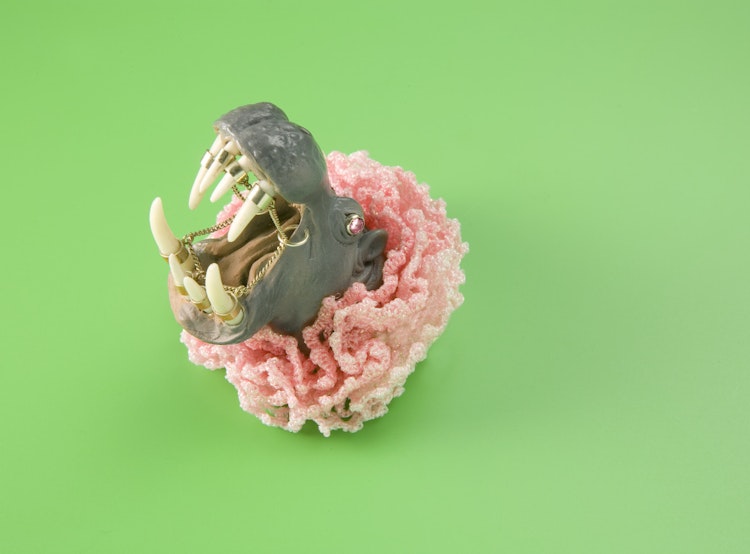

André Gali
Felieke van der Leest
Plastic toy animals, crocheting in yarn, and precious metals, are some of the elements Felieke van der Leest combines to make exciting, humorous, and absurd jewellery. Central to van der Leest's artistic practice is a fascination with the animal kingdom. Using toys and ready-mades she transformers animal figurines into near-human subjects, complete with clothes and sunglasses.
Born and raised in Emmen, a small town in the Netherlands, jewellery artist Felieke van der Leest now lives and works in Hardanger, in the west of Norway. She has, at age 42, an active, international career as a jewellery artist, and her works are included in several important museum collections around the world: from the Victoria & Albert Museum in London and The Museum of Fine Arts in Houston, to the Hiko Mizuno Collection in Tokyo and the Dutch Textile Museum in Tilburg. Working interdisciplinarily with textiles techniques and goldsmithing, her style of jewellery is playful yet glamorous, and her fabulations often include found toy animals, precious metals, and crocheted fabric.
Currently, she is exhibiting a selection of works made between 2002 and 2008, at Permanenten – the West Norway Museum of Decorative Art. In one way or another, all the selected works include animals. Van der Leest’s fascination for animals started when she was a child:
‘In the town of Emmen there is a zoo; one of the first to exhibit animals in their natural environment. For me, it was very common to see elephants and giraffes when I was growing up. My parents ran a business which included bulldozers and trucks for transporting sand and cranes. My father would tell me about how his crane had lifted a hippo, for instance, from a truck into its new accommodation.’
This suggests something about where van der Leest might get some of her imagery.
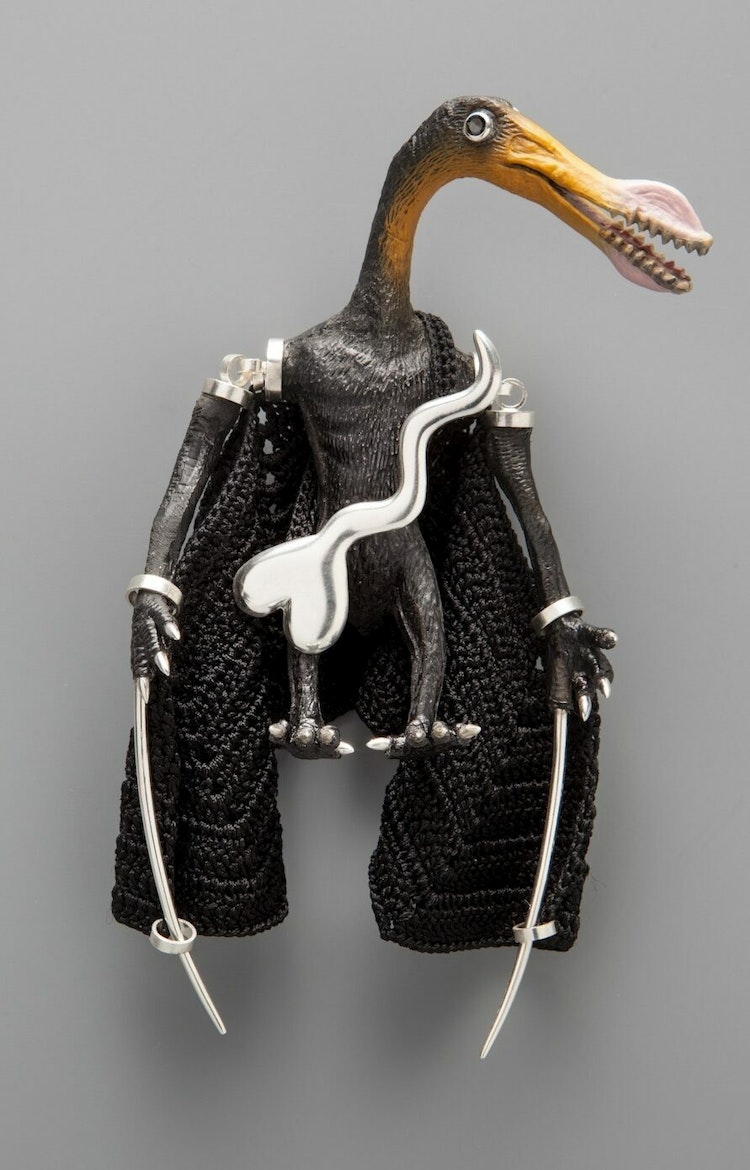
Jeweller by accident
While Felieke didn’t grow up in an artist family, most of her relatives liked being creative and were what she refers to as ‘do-ers’. Even though she learned knitting at an early age, her own creative interests did not develop until later. For most of her teenage years, she wanted to work with horses. But, at 17, all this changed into an interest in boys and partying:
‘So the horse was sold’ van der Leest remembers,
‘and I knew that I didn’t want to go to the university to study books. At the time, I was making my own earrings. This was in the ‘New Wave’ period with The Smiths, Simple Minds, U2, and so forth, you know. My biology teacher had noticed my earrings and advised me to go to the Technical School for Gold and Silversmithing in Schoonhoven.1 I didn’t even know that such a school existed.’
Enrolling in the school in Schoonhoven in 1986, van der Leest was inspired by Salvador Dali, because of his great imagination. She enjoyed Jugendstil (Art Nouveau) jewellery and Ancient Egyptian jewellery, but admits she was not really all that interested in jewellery art:
‘The last year of my traineeship at the technical school, I worked for a traditional metalsmith and for Sylvia Blickman, a contemporary jeweller. After graduation, I didn’t want to become a traditional metalsmith, so I applied for the Gerrit Rietveld Academie in Amsterdam.’
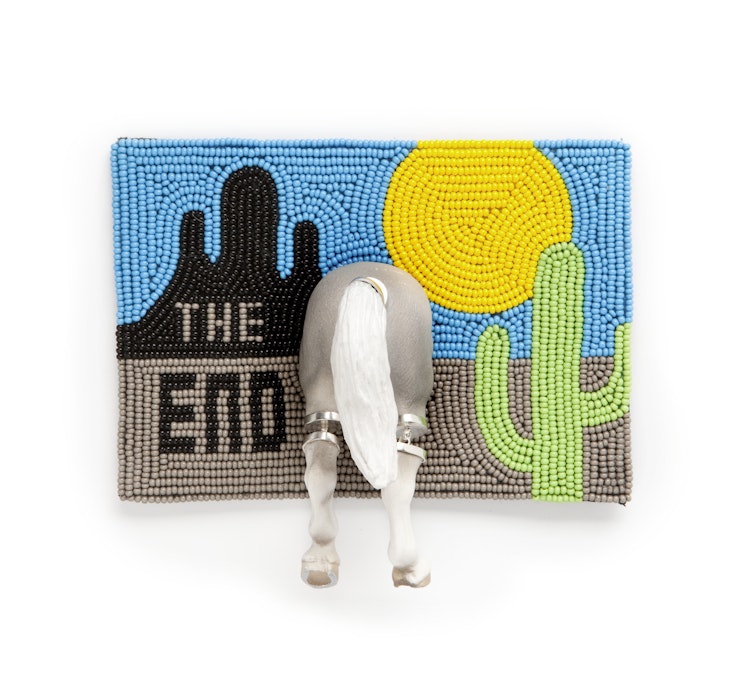
Formative years
Van der Leest started studying at the art academy’s fine arts department and took a basic course in drawing and painting, but after three months was so depressed with white paper and canvas that she wanted to quit:
‘I wanted to become a carpenter or car mechanic,’ she recalls.
Fortunately, Sylvia Blickman suggested she give the jewellery department a try:
‘I did as she suggested and found that I really liked to work in 3D, and to play with materials.’
But she wasn’t comfortable with the teaching methods at the academy. The work process was too slow and indirect, she thought. But when the class had industrial designer Marcel Wanders as a guest teacher for several months, van der Leest experienced a different type of work process:
‘He said to me, “If you have an idea, just do it. Don’t think too much about it.” That was revealing.’
Van der Leest remembers that jewellery artist Ruudt Peters, who was the head of the department, told her, ‘I know you have “it” in you, but “it” doesn’t come out.’
At the beginning of her final year, she invited Peters over to see her living environment, since “it” still hadn’t come out:
‘Lying on my table was a crocheted charm bracelet and a piece of textile chain I had made just for fun. He saw it and said that that was very special. I couldn’t believe it, because I thought it was something everybody could do. He told me to continue and that was what I did.’
From that moment on, she began crocheting and knitting all the ideas that popped into her head; but she had not yet included metal work, or the plastic animals, which she now is renowned for in her jewellery pieces.
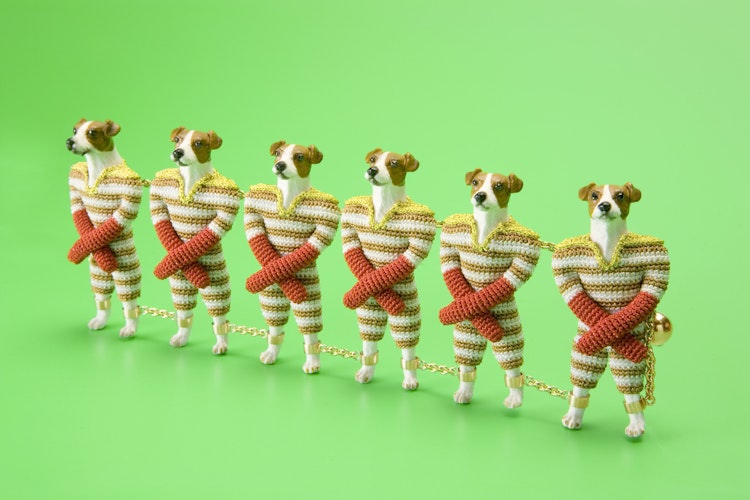
Jewellery fables
One of her first exhibitions was a solo show at Gallery Louise Smit in Amsterdam; this was in 1997. After graduating in 1996, she didn’t have to work very hard to get into exhibitions, van der Leest recalls. She was invited most of the time:
‘I think I was, at that time, very fortunate to be one of the first jewellers to use colourful textiles and crocheting in contemporary jewellery. I also got a lot of attention from the textile world. Making figurative and humorous works helped a lot in getting invited to take part in exhibitions. I even got coverage several times on Dutch TV.’
Almost immediately, she started selling to collectors and private buyers. And the Spermhearts, which she designed during her graduation year, are still selling well.
One of the first museums to buy her art was the Dutch Textile Museum in Tilburg:
‘Shortly after graduating, I made an appointment with the curator Caroline Boot, and she immediately bought three of the pieces I brought with me. That was super. That museum still buys my work regularly,’ she explains.
Since then, Felieke’s art has featured in exhibitions around the world: the Stedelijk Museum in Amsterdam, the Museum of Craft & Folk Art in San Francisco, Palazzo Bricherasio in Torino, the Society of Arts & Crafts in Boston, the Montreal Museum of Decorative Arts2 in Canada, the Estonian Applied Art Museum3 in Tallin and Jarfo in Kyoto, to name but a few.
Asked which shows van der Leest found especially enjoyable to do, one in particular comes to mind:
‘In 2006, I had a solo exhibition in Middlesbrough, England. At that time, MIMA (Middlesbrough Institute of Modern Art) was building their new museum, so I couldn’t have the exhibition in their building. I mounted it in the Dorman Museum; a regional museum with natural sciences, ethnographic, archaeological, and local social history collections. My work was exhibited in between their collection. It was so much fun to set up the exhibition and look for the best place for all the different pieces. MIMA also published my book Jewellery Fables.’
The book is beautifully made and gives a thorough introduction to van der Leest’s works, from her graduation to the exhibition at the Dorman Museum, and shows how she developed her crochet technique and started combining it with toy animals and precious metals.
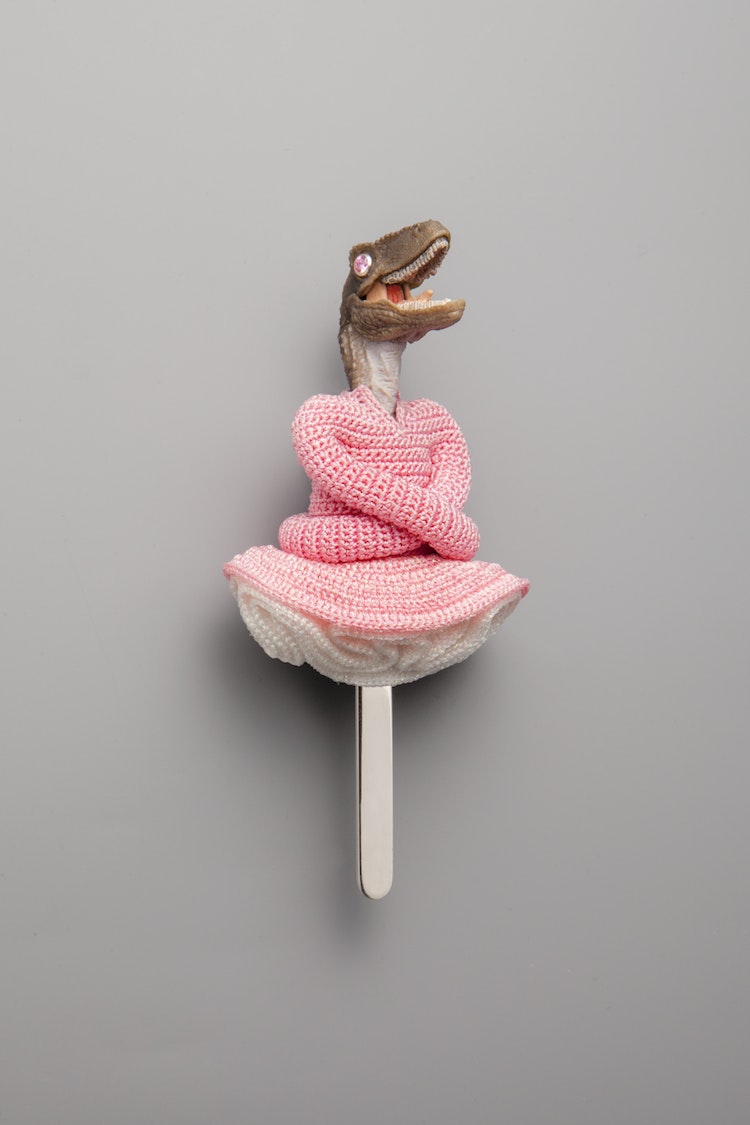
Jewellery circus
Four years later, van der Leest is delighted to be exhibiting in Permanenten – the West Norway Museum of Decorative Art in Bergen4:
‘It is my first big show in Norway, and I am very proud to have it in that museum. It is in the same space as their silver collection – it’s quite a contrast.’
Her works are shown in the same room as what is known as ‘the silver treasure, the goldsmithing art of Bergen.’ This is the first time Permanenten exhibits contemporary crafts together with their collection. Entitled Jewellery Circus, the exhibition presents 34 pieces van der Leest made from 2002 to 2008. She describes how the show came about:
‘A year ago, Kari Petterson asked me if I wanted to have an exhibition at Permanenten. Some months before that, I went to a symposium at the art academy in Bergen5 organised by, among others, [art historian] Jorunn Veiteberg. Jorunn, who has bought several works of mine, introduced me to Kari, and I gave her my book Jewellery Fables. I was also introduced to [curator] Anne Britt Ylvisåker, with whom I worked to create the exhibition.’
As the show’s title indicates, the jewellery includes animals in one way or another. This is how the museum’s webpage presents the exhibition:
‘With the uniqueness and humour of the hippopotamus-ring Prima Ballerina Hippo-Lolita and Cowboy Lion Cub’s Necklace, it is easy to understand why van der Leest’s works are popular.’
And all the jewellery on show is from van der Leest’s private collection:
‘I make small editions of my works, three to eight of each, for sale. But I also make one extra, the 0-number, for my private collection. I now have a large collection of my own works, specially made for exhibitions where the pieces don’t have to be for sale.
Human qualities
But what about her work process? How does she start creating a piece of jewellery and where does her inspiration come from?
‘I am surrounded by hundreds of plastic toy animals in my studio. At times, I get ideas about some of them. I try to imagine what to do with them, how to make them into a new piece. When I think I have an interesting idea, I start working. I often start working on the textile part,’ she reveals. Because crocheting is a very slow technique, van der Leest gets more ideas while working. If she has a bad feeling about how the work is developing, she begins to change the piece:
‘Sometimes I have to change size, colour, and material. And sometimes I have to change the whole idea.’
Slowly the piece develops, and the end result can be completely different from the original idea.
But, I have to ask, ‘why plastic toy animals?’
‘I like to work with animals because there are so many different types. Their inspiration is endless because of their special characteristics and shapes. Animals also have a strong connection to humans; we anthropomorphize them in our fairytales. Enough to play with', she explains.
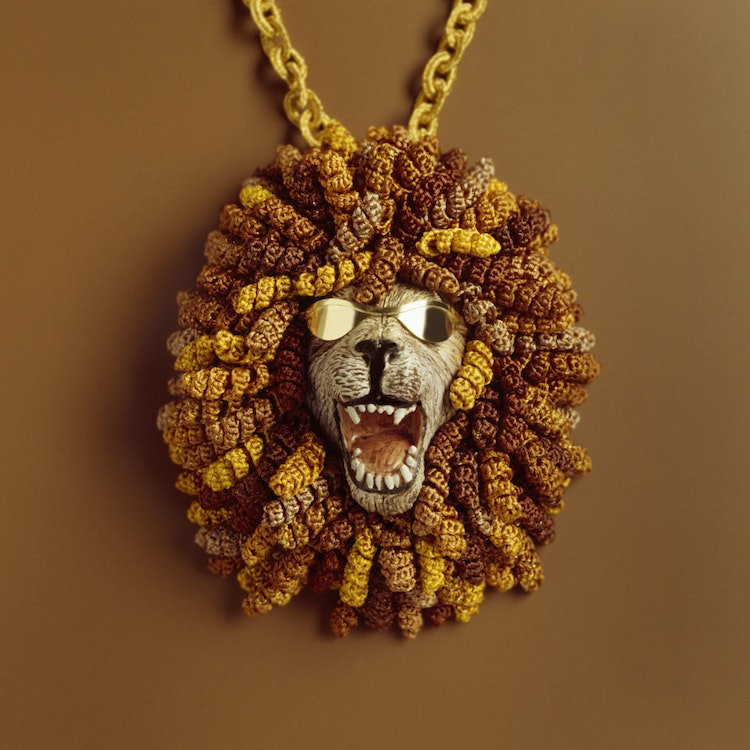
Behind the jewels
On request, van der Leest gives me two examples on how a work can come into existence. The first is about her work Brian the Lion, from 2003:
‘One time, I was in Scotland to give a lecture in a small museum. The museum had a stuffed animal section, and here I discovered this stuffed lion at the entrance. He was not in one piece, only his head and front legs were exhibited. His name was Brian the Lion,’ she begins.
‘For many years, I had had this large plastic toy lion in my studio, just waiting to be used. I decided to cut off his face and make a pendant. At first, I wanted to give my Brian the Lion gemstone eyes, but when I did, I got a very bad feeling about it. That was not a good sign. It was a very hot summer and everyone was wearing sunglasses. So, I changed from gemstone eyes to sunglasses. I made several models, but this one was the coolest.’
The work was so successful, it ended up on the front cover of a Dutch art magazine.
Also, The J. Russells, from 2008, has an interesting story behind it. The Jack Russell terrier is a short-legged dog, ‘very tough and macho,’ she informs me.
‘In a soccer game, there is sometimes this situation where the players line up in front of the goal. They make a “wall” — to protect their private parts from being hit by the ball, they cover themselves with their hands. This always looks very funny to me. I changed that and crossed their arms and made the sleeves red to look like crosses. A red cross has different meanings. Their clothes are crocheted with yarns normally used for machine embroidery. I used two threads viscose and one thread of metallic to give it a little glitter.’
Van der Leest experimented with different ways of connecting the dogs, but most of the methods were too technically complicated:
‘I like simple solutions, so I chained them together with golden shackles. By doing that, they gained a new association to prisoners, and to The Daltons from the cartoon Lucky Luke.’
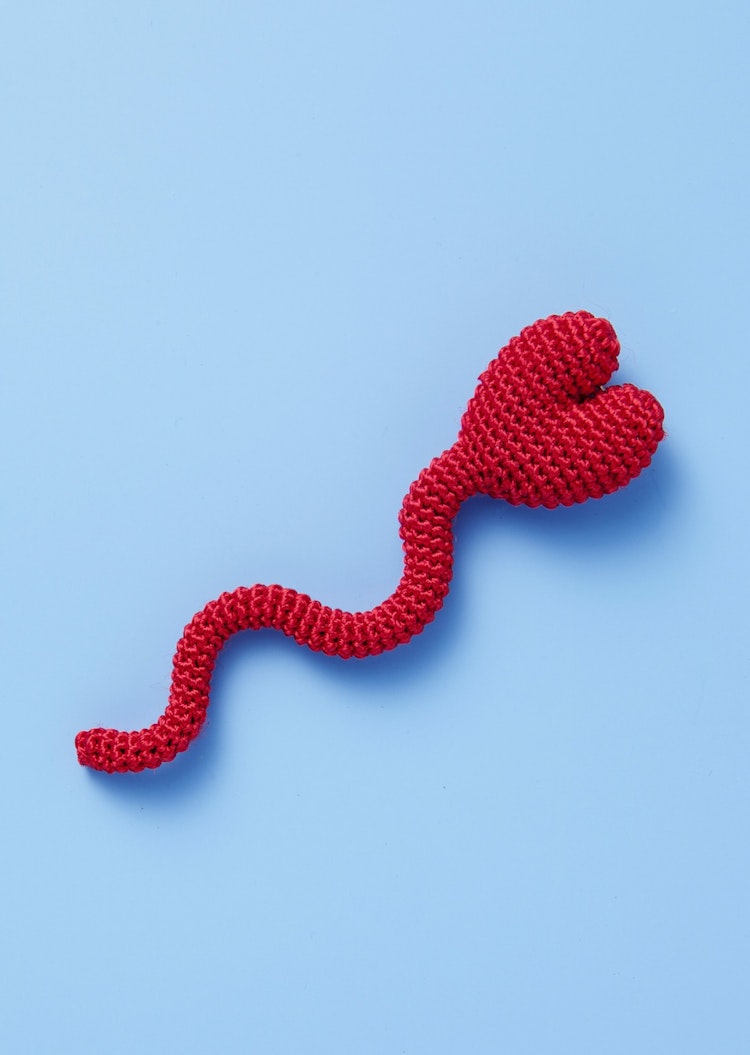

Workaholic
Although van der Leest is trained as a metalsmith, metal and smithing techniques are not her favourites. She puts it like this:
‘I’m not a real metal person. I’m more a textile person, I think. My mother taught me textile techniques as a child and I always had “something on my needles” when watching TV. At the jewellery department of the art academy, I used all kinds of new materials; I didn’t want to work with metal and metalsmithing techniques. I didn’t find it to be challenging.’
But as she started to work with textiles again, in the final year of her education, she realised anew that she loved crocheting and knitting.
‘I didn’t have to learn new techniques, nor did I need expensive equipment or materials, or a large workspace. Also, you can get textiles in all different colours. That was something I didn’t like about working in metal – it is so colourless…’
But after six years of continuously crocheting, pain started shooting up her arms and she realised her rote movements had to change.
‘I decided to incorporate the metal smithing techniques in my work, since the movements are very different. I already had a large collection of toy animals, so I started to combine them. I don’t consider myself as a person who likes to experiment; I just work with the metal and textile techniques that I know.’
Since Felieke sees herself as something of a workaholic, she felt quite depressed about having to stop working for a while. Now, however, reflecting back on that period, she feels her work has changed for the better.